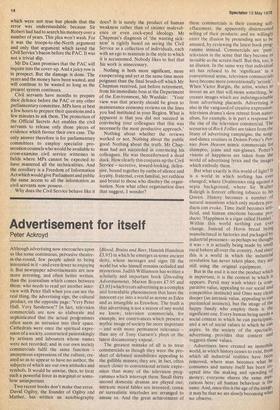Advertisement for itself
Peter Ackroyd
Although advertising now encroaches upon us like some continuous, pervasive theatrein-the-round, few people admit to being interested in it — and even fewer to enjoying it. But newspaper advertisements are now more arresting, and often better written, than the journalism which comes between them: who needs to read yet another interview with Peter Hall when you can see the real thing, the advertising sign, the cultural product, on the opposite page: 'Very Peter Hall. Very Sanderson'? In fact, television commercials are now so elaborate and sophisticated that the actual programmes often seem an intrusion into their space. Cathedrals were once the spiritual expression of a society, constructed painstakingly by artisans and labourers whose names were not recorded; and in our own society commercials fulfil the same function — anonymous expressions of the culture, created so as to appear to have no author, the subjects of which are our own attitudes and symbols. It would be unwise, then, to treat such a powerful force as marginal or some'how unimportant.
Two recent books don't make that error. David Ogilvy, the founder of Ogilvy cnd Mather, has written an autobiography
(Blood, Brains and Beer, Hamish Hamilton £3.95) in which he emerges as some ancient deity, whose messages and signs fill the world but who himself remains occluded and mysterious. Judith Williamson has written a scholarly and important book (Decoding Advertisements, Marion Boyars £7.95 and £3.95) which treats advertising as a complex and formidable phenomenon that lures the innocent eye into a world as serene as Eden and as intangible as Erewhon. The truth is that advertising is not a mirror of any world we know; television commercials, for example, are contrivances which present a mythic image of society far more important — and with more permanent relevance — than any of Tony Garnett's plays or the latest documentary exposé.
The greatest mistake of all is to treat commercials as though they were the product of debased sensibilities appealing to the gullible masses; they are, in fact, often much closer to conventional artistic expression than many of the television programmes which interrupt them. Small thirty second domestic dramas are played out; intricate moral fables are invented; comic or surrealistic interludes are arranged to amuse us. And the great achievement of
these commercials is their cunning selfeffacement, the apparently disinterested selling of their products: and we willinglY enter the illusion by pretending not to be amused, by reviewing the latest book prog; ramme instead. Commercials are 'pure television in the sense that they become as invisible as the screen itself. But this, too, Is
an illusion. In the same way that individual art has refused to be 'significant' in a conventional sense, television commercials have become more conventionally 'artistic'. When Victor Burgin, the artist, wishes to invent an art that will mean something, he creates images which are indistinguishable from advertising placards. Advertising Is also in the vanguard of creative expression: television drama's slow retreat from naturalism, for example, is in part a response to the rise of the television commercial. The scenarios of Rock Follies are taken from the litany of advertising campaigns; the songand-dance routines in Dennis Potter's Pennies from Heaven mimic commercials for shampoo, jeans and sun-glasses. Potter's visions of happiness are taken from the world of advertising lyrics and the images which embody them.
But what exactly is this world of light? It is a world in which nothing has ever changed; where Ovalteenies sing against a sepia background, where Sir Walter Raleigh is forever offering tobacco to his Queen. History becomes a number of natural sensations which only modern products can evoke. Time itself becomes artificial, and human emotions become pro: ducts: 'Happiness is a cigar called Hamlet Within this world nothing can ever change. Instead of Hovis bread being manufactured in factories and packaged IV industrial processes as perhaps we thought it was — it is actually being made by small rural bakers all over the country. And since this is a world in which the industrial revolution has never taken place, they are still using the original equipment.
But in the end it is not the product whie,h is important, it is the context in which It appears. Persil may wash whiter (a coolparative value, appealing to our social and competitive instincts) and Omo may clean deeper (an intrinsic value, appealing to our puritanical instincts), but the image of the happy family who employ them is the significant one. Every human being needs a social context in which he can participates and a set of social values to which he can aspire. In the society of the spectacle, advertising provides that context and suggests those values.
Advertisers have created an immobile world, in which history ceases to exist, from which all industrial realities have been removed, where man becomes what he consumes and nature itself has been co
opted into the making and spending 0,f
money; everyone shares the same asp' rations here; all human behaviour is the
same. And, since this is the age of the images it may be that we are slowly becoming what we observe.


































 Previous page
Previous page